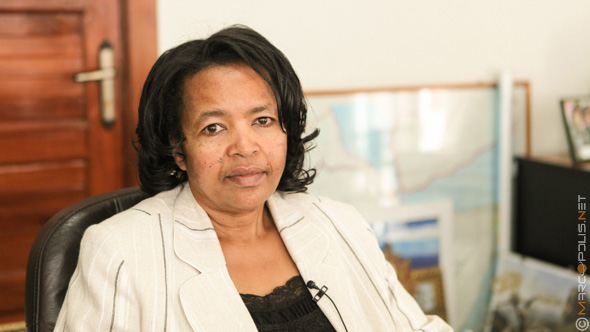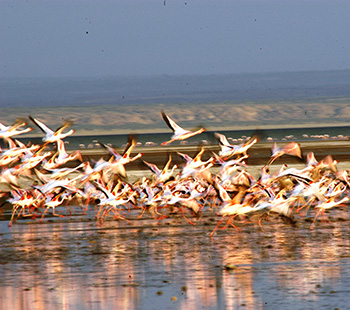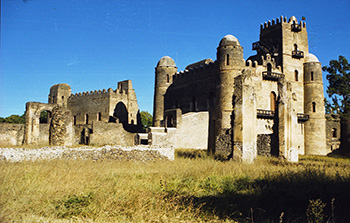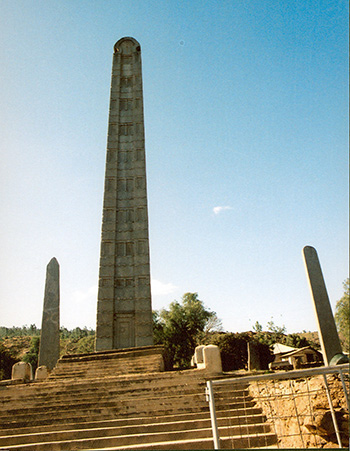Exclusive interview with the State Minister of Culture and Tourism of Ethiopia, H.E. Tadelech Dalacho Dando
H.E. Tadelech Dalacho Dando, State Minister of Culture and Tourism
Ethiopia is unique in terms of its tourist attractions. There is a combination of all types of attractions here; natural, cultural and historical. The vision of the Ministry of Culture and Tourism in Ethiopia is to make it one of the top 5 tourist destinations in Africa by 2020, and the government together with the private sector is currently working hard to accomplish this dream.
Interview with H.E. Tadelech Dalacho Dando, State Minister of Culture and Tourism

Ethiopia is perhaps one of the richest countries in the world when it comes to history and culture. Can you give us a brief description of Ethiopia and its culture?
As you said, Ethiopia is unique in terms of its tourist attractions. There is a combination of all types of attractions here, from cultural to natural and historical; even the humanity has its origin here in Ethiopia. In terms of cultural attractions in Ethiopia, we have more than 80 different ethnic groups, which means we have many different types of cultural identities, activities and lifestyles. There is a mosaic of diverse cultural identities here in Ethiopia.
What is your opinion regarding the potential for tourism in Ethiopia and do you think it will become one of the top travel destinations in Africa?
Ethiopia offers very unique and diversified tourism attractions. The vision of the Ministry of Culture and Tourism in Ethiopia is to make it one of the top 5 tourist destinations in Africa by 2020. We are working hard to make this happen. This vision emanates from the existing resource potential. We have had peace and security for the past 22 years. The government is stable and so tourists can travel throughout the country all year round without problems. Ethiopia is an ancient country with records going back 3,000 years B.C. We are one of the oldest countries and so our rich history is a great tourist attraction. We are also known for our scientific findings.  The 3.2 million year old skeleton Lucy was discovered in Ethiopia and there are many other scientific findings that place Ethiopia as the origin of humanity. Many tourists would like to come and see the place where our ancestors came from before they spread throughout the world.
The 3.2 million year old skeleton Lucy was discovered in Ethiopia and there are many other scientific findings that place Ethiopia as the origin of humanity. Many tourists would like to come and see the place where our ancestors came from before they spread throughout the world.
We also have very diverse natural attractions. We have very high mountains in the Simien National Park. We also have the lowest place in the world in Dallol in the Afar region. There are many contrasting natural attractions here. We have so much diversity. Even the climate in Ethiopia is unique. We have a mild temperature all year round, which is very agreeable to travellers.
We also have many UNESCO registered sites and we are a leading UNESCO member in Africa. This goes to show how much potential there is in this country.
At the moment the benefits we are getting from all these tourist attractions are not significant in respect to the great potential that we have. This is due to different problems; twenty years ago this country was at war, there were many national problems, and we suffered from drought etc. There were so many problems and our image was associated with all these negatives. Furthermore due to the war, the infrastructure here is very poor. Therefore we have all of this potential but unless the infrastructure is developed and the private sector is enhanced in the country, it remains difficult to attract tourists.
Last year we welcomed about 650,000 visitors, which is a 12% increase as opposed to the previous year. Our plan is to attract around 1 million tourists per year. We aim to earn around 3 billion USD from the tourism industry.
At the moment the government is really committed to improving the infrastructure and so the country is connected in all directions by asphalted roads and also by air connections which substantially helps the tourism industry advance. Overall the image of the country is changing due to our economic development. Ethiopia is one of the fastest growing countries economically speaking. As a result, the tourism industry is really taking over and we are on a positive trend now. In the past we were not competitive but now we can be one of the most competitive tourist destinations in Africa.
You mentioned that by 2020 your aim to become one of the top tourism destinations in Africa. How is the Ethiopian government supporting the tourism industry?
The government’s support for the tourism industry at the moment is visible. The government has now developed a tourism industry policy whereas in the past the tourism industry had no government policies or direction. Currently there is a policy and there is a strategy to implement it. The government is investing in destination development, particularly at a regional and destination level. The government has endorsed new regulations with the Tourism Transformation Council and there was an Ethiopian Tourism Organisation established recently that will focus on destination development and marketing.
Therefore many institutions under the Ministry are working in different areas: for instance the Wildlife Conservation Authority is working on the National Parks and legalising more parks into their boundaries. The Cultural Attraction Conservation group is also working in different areas such as cultural and natural heritage. The regulation implemented is a recent development. H.E. the Prime Minister of the Federal  Democratic Republic of Ethiopia is the chairperson of the Tourism Transformation Council and members are Presidents of the regional states, mayors of the city administrations, ministers, religious leaders, private sector representatives, renown personalities. This is a clear manifestation of the commitment of the government to boost the tourism development of the country. In addition the government is encouraging the private sector involvement by providing different incentive packages. The members will come together to consult and discuss value chain issues and will aim to create awareness of all aspects of the tourism industry. Therefore we can say that the government is committed to developing the tourism industry.
Democratic Republic of Ethiopia is the chairperson of the Tourism Transformation Council and members are Presidents of the regional states, mayors of the city administrations, ministers, religious leaders, private sector representatives, renown personalities. This is a clear manifestation of the commitment of the government to boost the tourism development of the country. In addition the government is encouraging the private sector involvement by providing different incentive packages. The members will come together to consult and discuss value chain issues and will aim to create awareness of all aspects of the tourism industry. Therefore we can say that the government is committed to developing the tourism industry.
How is Ethiopia working on increasing its competitiveness in the tourism industry in comparison to its neighbouring countries?
We address the potential of tourism from different tourist generating countries. We look at the emerging markets and the older markets such as the European and American markets. There are different tourism trade fairs and exhibitions that we attend in different European and other Western countries. The Ministry—along with various tourism operators— participates directly in these fairs. We invite different media from various tourism generating countries as well as travel agents to come on a familiarisation trip where they come here and stay a week or two travelling throughout the country before going back to their countries to work on both print and electronic media to promote what they have seen. Our embassies abroad are also working on promoting the Ethiopian tourism industry being directly connected with the major tour companies in their respective countries. These are some of the different mechanisms that we use to try to promote awareness of our tourism industry abroad.
Due to the change of image and all of these activities that we are carrying out, we are now calling ourselves “New Ethiopia” because everything is changing here, from the infrastructure to the economy. The tourism industry has benefited from all of this and has been growing for the past 5 years. The industry’s annual growth has been at a rate of more than 12%.
 How many visitors does Ethiopia attract on average per year?
How many visitors does Ethiopia attract on average per year?
Last year we welcomed about 650,000 visitors, which is a 12% increase as opposed to the previous year. Our plan is to attract around 1 million tourists per year. We aim to earn around 3 billion USD from the tourism industry.
Is there any specific region that you are focusing on attracting tourists from?
I would say that our primary market is the United States, Germany, UK, France and Italy. Holiday and vacation tourists come particularly from those countries. Thus we focus on those top destinations. The secondary market includes other European countries like the Netherlands and Spain, and also Japan. Now we are also focusing on emerging markets like China, Russia and India since their economies are growing well and they are becoming world economic powers. We are also working with our neighbours Kenya and Sudan to offer package trips to Ethiopia and these countries. We have started working with operators in those countries to offer such packages because our attractions are complementary. For instance if you go to Kenya, it is often for safari type attractions but if you combine it with a trip to Ethiopia, you add cultural and historical attractions to the trip and so the tourists will receive a more comprehensive view of Africa.
An advantage that we have is our airline, Ethiopian Airlines, which is a world standard airline and a member of Star Alliance. It flies to many international destinations which makes Ethiopia a hub for air travel and thus increases our competitiveness. We also have the headquarters of the African UN and many other different international organisations here in Ethiopia. We are considered a diplomatic location.
 We know that there are 9 historical sites in Ethiopia that are registered as UNESCO heritage. Can you tell us a little bit about the most attractive ones?
We know that there are 9 historical sites in Ethiopia that are registered as UNESCO heritage. Can you tell us a little bit about the most attractive ones?
For us, all of them are attractive because all of them have their own unique qualities. Each site has its own unique culture associated with it. Aksum is a site that has ruins which tell 3,000 years of history and that makes it a unique site. In Gondar, the castle of the emperor Fasilides is from the 16th century and it is also very special. Then you have Lalibela which most people consider to be one of the most important sites here. There, you will find 11 churches carved out of the living rock that were built in the 12th century and yet still today are in use with the church holding mass there. Personally I love this site. I suppose it is the site that everybody talks about. There is also Harar city which is an Islamic walled city and there is Hadar which is where Lucy, the 3.2 million year old skeleton was found. Each site is different and has its own quality and value.
The 9 UNESCO registered sites in Ethiopia include the Simien National Park, Aksum, Fasil Ghebbi, Gondar Region, Harar Jugol (the Fortified Historic Town), Konso Cultural Landscape, Lower Valley of the Awash, Lower Valley of the Omo, Rock-Hewn Churches in Lalibela, and Stelae Tiya.
Finally, what is your personal vision for Ethiopia?
I share the vision held by the country as a whole. Ethiopia’s vision is to become a middle income country in the medium term. The government, the private sector and all Ethiopians are all working hard to obtain this goal because we all want to see our citizens lifted from poverty. I share this vision and I am working on making it happen. I want to see the government’s vision for Ethiopia fulfilled.
FAIR USE POLICY
This material (including media content) may not be published, broadcasted, rewritten, or redistributed. However, linking directly to the page (including the source, i.e. Marcopolis.net) is permitted and encouraged.